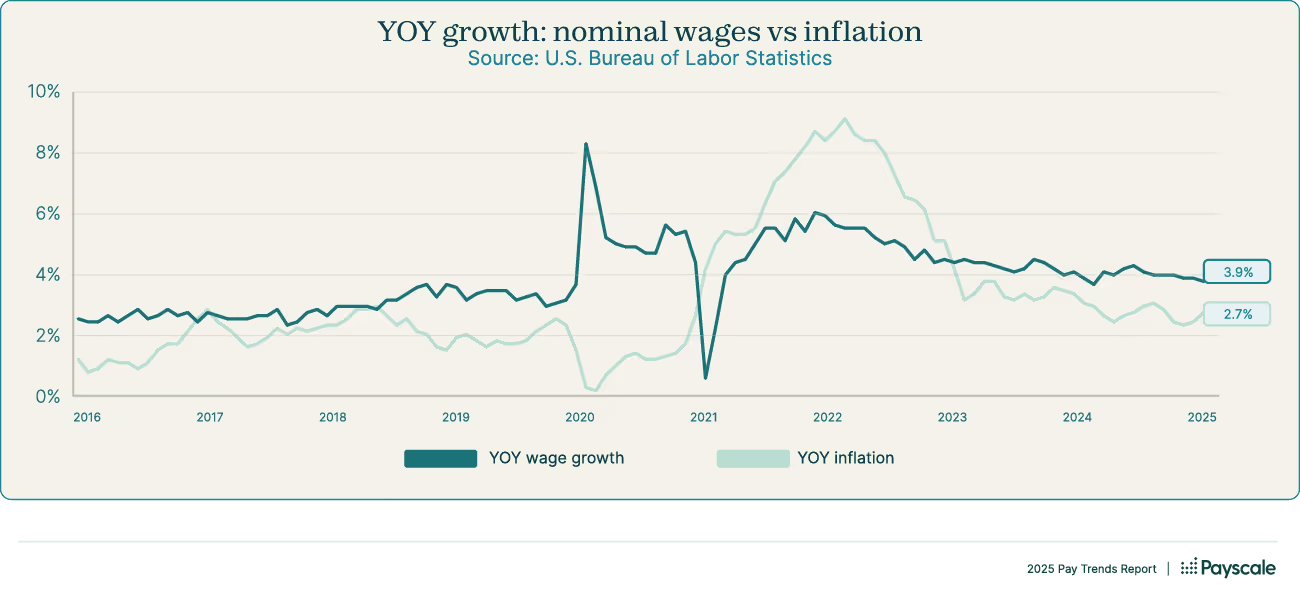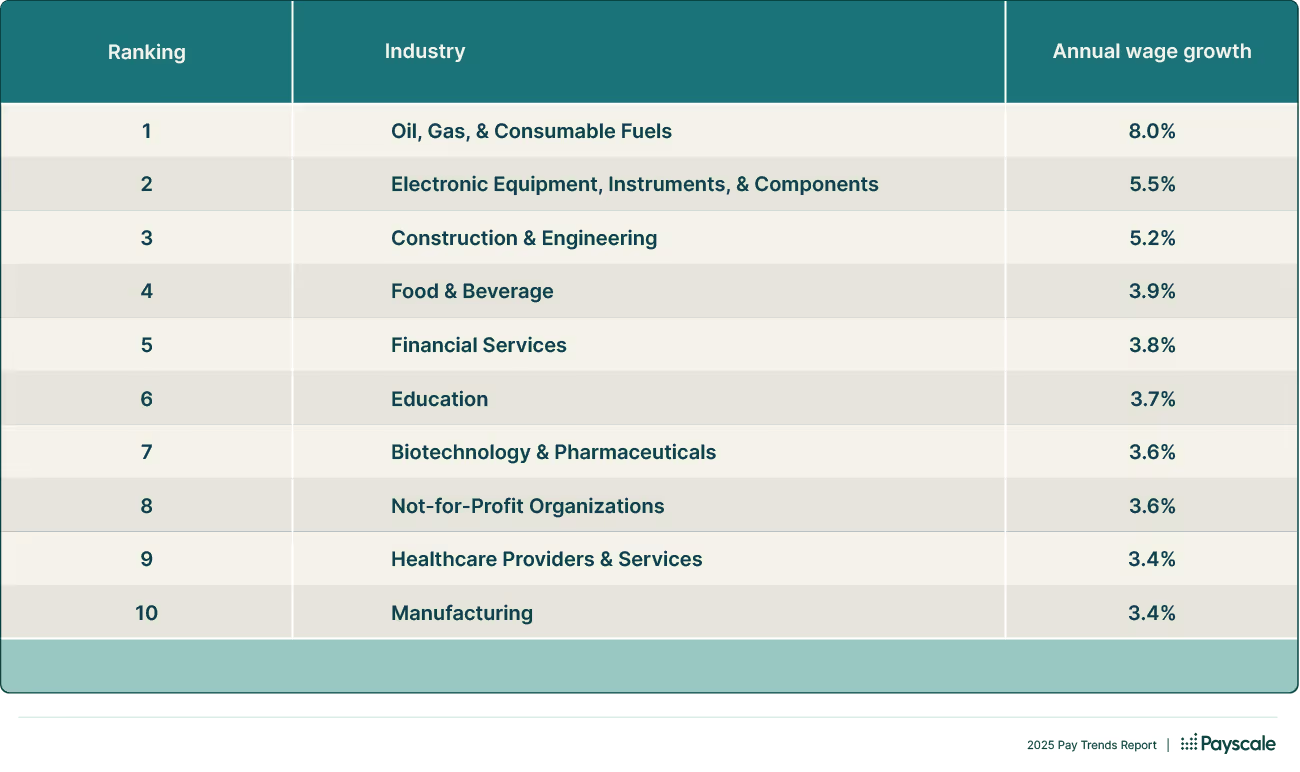The U.S. labor market is showing signs of stagnation with wage growth slowing for many workers.
Don’t tell Oil, Gas, and Consumable Fuels because salaries are skyrocketing, even as the industry has seen job cuts in certain sectors.
HR practitioners need industry-specific pay data more than ever. Even as the labor market wobbles and salary increases slow, certain industries are seeing wage increases driven by talent scarcity and sector-specific pressures.

Let’s first zoom out.
In September 2025, the U.S. Bureau of Labor Statistics (BLS) announced that only 22,000 jobs were created in August. The BLS also revised job numbers down by nearly one million for the year before March 2025, with a net decline of 13,000 jobs for June.
This marked the first monthly job loss since December 2020 during the Covid-19 pandemic.
The Job Opening and Labor Turnover Survey (BLS JOLTS) data, most recently published for August 2025, showed a very small uptick in job openings and quits rate. The numbers barely budged from when we pulled data for our report. This minimal movement indicates a labor market where workers are reluctant to leave their roles, a trend informally known as “job hugging.”
With unemployment climbing to 4.3% (the highest since late 2021), employees are staying put. At the same time, the labor force participation rate, which had been on the rebound from pre-Covid levels, has fallen to 62% in recent months. This might suggest long-term unemployed workers have simply given up looking for work.
Labor market sluggishness may be adversely impacting wage growth.
While wage growth has outpaced inflation since 2023, it has been on the decline since mid-2022. Wage increase percentages are above average, but they’re still less than we’ve seen in previous years.

These workforce dynamics seemingly benefit employers in the short term, although labor market stagnation and lower wage growth can negatively affect organizational health as employees become increasingly disengaged.
But this picture of pay trends isn’t consistent across industries. While macro trends tell one story, pay growth varies considerably by sector. And for HR practitioners, the wage growth in your industry matters much more than national averages.
What contraction? Electronics, Oil & Gas, and Construction & Engineering have high growth in the cost of labor.
Oil, Gas & Consumable Fuels isn’t just running ahead in wage growth — it’s dominating at 8% in 2025. What’s driving this upward movement? It’s likely a combination of access to resources, U.S. energy market deregulation, and geopolitical conflicts disrupting global supply.
As the Russia-Ukrainian War continues and political instability in the Middle East grows, domestic fuel production makes up the difference, intensifying competition for skilled talent.
Posting 5.5% wage increases in 2025, Electronics and Components face a different challenge: workers are retiring and the market for younger talent is insufficient to meet demand. This will be a challenge for many industries in the future as the labor pool shrinks.
Hard-wired technology may lack the glamour of Big Tech, but its workforce has the luxury of both job security and larger wage increases.
Construction & Engineering may also be feeling labor shortages, which partly accounts for the 5.2% wage increases in 2025. The industry has also been buoyed by infrastructure outlays at federal and state levels.
Check out the top industries by annual wage growth:

Further down the list, we have Food & Beverage with 3.9% wage increases to address persistent turnover (a hallmark of the industry) and lingering post-pandemic workforce gaps.
Financial Services also shows steady 3.8% wage increases, driven by the demand for particular jobs: notably, risk management specialists, compliance experts, and (here it comes) AI-literate analysts.
With the emergence of different financial products (think crypto banking and P2P providers like Zelle and Venmo), risk and compliance specialists will continue to be in-demand jobs.
Meanwhile, wages grew in Education by 3.7%. Teacher shortages are driving salary increases as more professionals leave the field due to low pay and deteriorating working conditions.
Higher education is also playing catch-up after years of wage stagnation. With uncertainty over federal funding and questions about the value of a four-year degree, America’s colleges and universities face budgetary challenges.
The same holds true in the Non-Profit sector. Non-Profits are competing with more lavish salaries in the private sector. Wage growth is larger in specialized areas like social services and mental health where burnout is high, pay is lower than average, and qualified candidates are limited.
In Biotechnology & Pharmaceuticals, wages spiked after the pandemic with a growing demand for drug innovation. Although after these post-pandemic highs, wage increases have become more muted.
Following a hiring binge in 2022 and 2023, Biopharma has been a mixed bag. Salary increases are holding firm, but major companies have also announced layoffs. The industry is grappling with this wage growth against a backdrop of patent cliffs and declining investment.
While Healthcare continues to experience high job growth due to persistent labor shortages and higher demand for services, wage growth (currently at 3.4% for 2025) has started to level off. This is due to rising operational expenses and more restrictive funding.
Finally, with all the public rhetoric surrounding the decline of Manufacturing, the industry has experienced 3.4% wage growth. Demand for skilled workers and reshoring efforts have driven up the cost of labor.
As you can see, relying on national averages for salary decisions is a poor strategy. Wage growth has slowed, yet your industry might be experiencing 8% growth.
Of course, the reverse could be true as well. Organizations plan 3.5% pay increases in 2026, but your industry averages a more modest 2.5%.
Basing pay ranges on national averages is like listing your house based on the median home price. It doesn’t account for the difference in value between San Francisco and rural Nebraska.
When Electronics & Components delivers 5.5% wage growth and Healthcare sits at 3.4%, this generalized labor market “intelligence” creates two distinct risks:
- Your pay ranges fall short of industry-specific realities (cue increased regrettable turnover and expanding time to fill)
- Your pay ranges exceed what’s necessary (your budget becomes unnecessarily strained)
Your answer: Payscale Industry Networks
To align your pay ranges with the actual costs of labor in your sector, think about joining Payscale’s Industry Network.
Powered by Peer, Payscale Industry Networks offers compensation professionals benchmarked salary data from competitors in their sector and talent market. It equips you to price jobs with precision, comparing your pay ranges directly to similarly situated organizations by role, workforce composition, and geography.
With Peer, you can quickly segment by industry or region, revealing exactly what your closest competitors are paying for talent in your market. This data is especially valuable for in-demand positions where traditional surveys lag the market.
Combining other market data with Peer Insights, HR practitioners can confidently adjust pay ranges to mirror the market. This sustains your market competitiveness, supports retention efforts, minimizes pay compression, and ensures pay equity.




.png)

